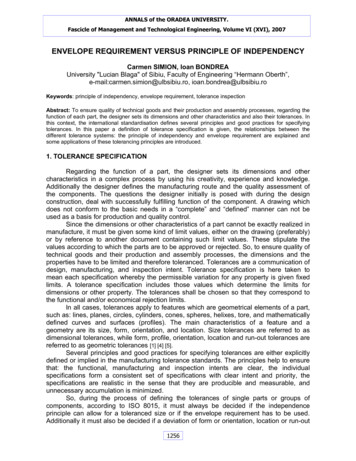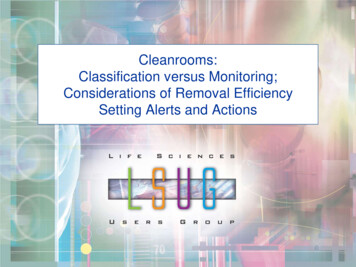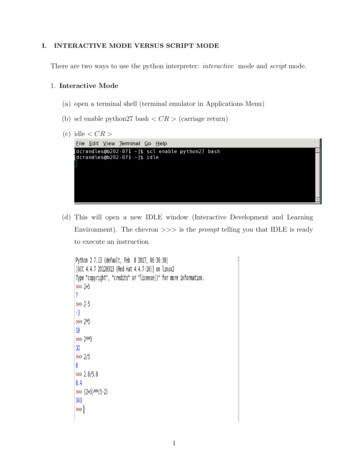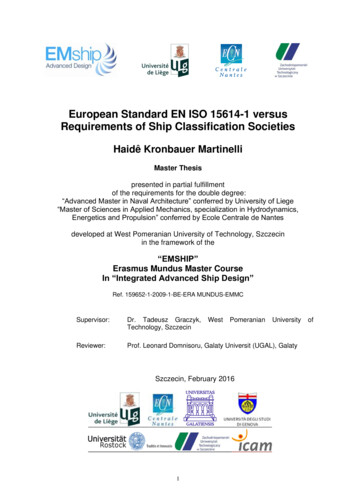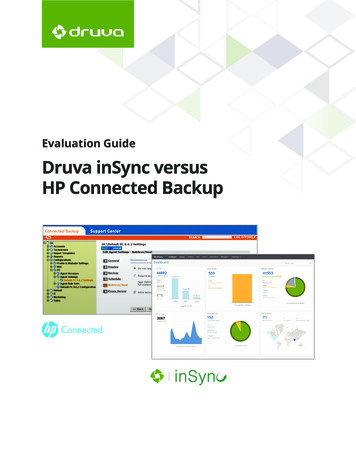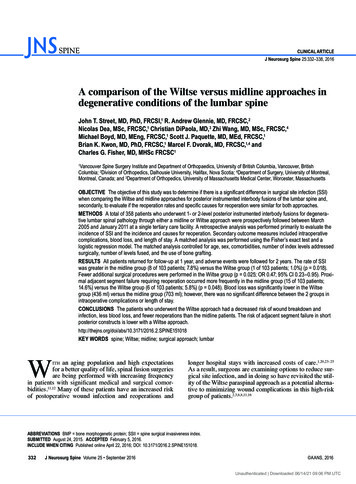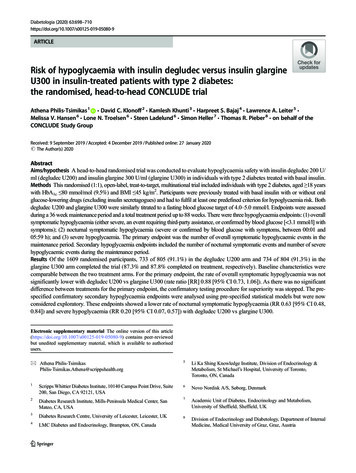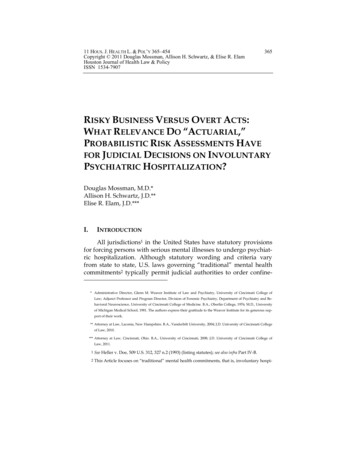
Transcription
11 HOUS. J. HEALTH L. & POL’Y 365–454Copyright 2011 Douglas Mossman, Allison H. Schwartz, & Elise R. ElamHouston Journal of Health Law & PolicyISSN 1534-7907365RISKY BUSINESS VERSUS OVERT ACTS:WHAT RELEVANCE DO “ACTUARIAL,”PROBABILISTIC RISK ASSESSMENTS HAVEFOR JUDICIAL DECISIONS ON INVOLUNTARYPSYCHIATRIC HOSPITALIZATION?Douglas Mossman, M.D.*Allison H. Schwartz, J.D.**Elise R. Elam, J.D.***I.INTRODUCTIONAll jurisdictions1 in the United States have statutory provisionsfor forcing persons with serious mental illnesses to undergo psychiatric hospitalization. Although statutory wording and criteria varyfrom state to state, U.S. laws governing “traditional” mental healthcommitments2 typically permit judicial authorities to order confine* Administrative Director, Glenn M. Weaver Institute of Law and Psychiatry, University of Cincinnati College ofLaw; Adjunct Professor and Program Director, Division of Forensic Psychiatry, Department of Psychiatry and Behavioral Neuroscience, University of Cincinnati College of Medicine. B.A., Oberlin College, 1976; M.D., Universityof Michigan Medical School, 1981. The authors express their gratitude to the Weaver Institute for its generous support of their work.** Attorney at Law, Laconia, New Hampshire. B.A., Vanderbilt University, 2004; J.D. University of Cincinnati Collegeof Law, 2010.*** Attorney at Law, Cincinnati, Ohio. B.A., University of Cincinnati, 2008; J.D. University of Cincinnati College ofLaw, 2011.1See Heller v. Doe, 509 U.S. 312, 327 n.2 (1993) (listing statutes); see also infra Part IV-B.2This Article focuses on “traditional” mental health commitments, that is, involuntary hospi-
366HOUS. J. HEALTH L. & POL’Yment of individuals who have serious or “substantial” mental disorders that cause “gross” impairments in their functioning, but only if“clear and convincing” evidence3 shows that those individuals poserisks of harm to themselves or others.4During civil commitment hearings, a portion of the evidencesupporting involuntary hospitalization sometimes comes from nonprofessional fact witnesses—family members or acquaintances of therespondent, or law enforcement officers—who testify about aspectstalization of persons traditionally viewed as needing treatment for severe mental illness.Such persons typically have psychoses (severe disturbances of thinking) or affective disorders that grossly compromise their ability to perform everyday living tasks. Examples ofsuch conditions include schizophrenia and bipolar disorder. Our use of “traditional” to describe mental health commitments follows John Monahan, A Jurisprudence of Risk Assessment: Forecasting Harm Among Prisoners, Predators, and Patients, 92 VA. L. REV. 391, 395, 433–34 (2006). Professor Monahan, a psychologist, uses the term “traditional” to express theview held by most mental health professionals that mental health commitments differ importantly from the indefinite confinement of sex offenders allowed by more than twentyU.S. jurisdictions following completion of a prison term. In upholding sex offender commitments as a constitutional use of state power, the U.S. Supreme Court did not recognizethis distinction. See Kansas v. Hendricks, 521 U.S. 346, 357–58 (1997) (Kansas sex offendercommitment statute was “plainly of a kind with” mental health commitment laws becauseit “require[d] a finding of . . . dangerousness” caused by “a ‘mental abnormality’ or ‘personality disorder’ that makes it difficult, if not impossible, for the person to control his dangerous behavior”).We also note that this Article focuses on criteria for inpatient hospitalization. Forty-four U.S.jurisdictions permit courts to order “outpatient commitment” under statutes that requireindividuals to obtain psychiatric treatment while they live in the community. Marvin S.Swartz et al., Assessing Outcomes for Consumers in New York’s Assisted Outpatient TreatmentProgram, 61 PSYCHIATRIC SERVICES 976, 976 (2010). Often, the statutory requirements permitting outpatient commitment are less stringent than those governing involuntary hospitalization. See, e.g., N.Y. MENTAL HYG. LAW § 9.60(9)(c) (McKinney 2006) (criteria for assisted outpatient treatment require having a mental illness, likelihood of not being safe orparticipating in voluntary treatment, likelihood of relapse, previous noncompliance withtreatment, two hospitalizations in last thirty-six months, and violence or threats in the pastfour years); MICH. COMP. LAWS § 330.1401(d) (West 2010) (listing criteria for assisted outpatient treatment that differ from criteria for involuntary hospitalization).3To satisfy due process, the minimum burden of proof applicable to a civil commitment caseis “‘clear and convincing’ evidence.” Addington v. Texas, 441 U.S. 418, 431, 433 (1979)(“[T]he precise burden [must be] equal to or greater than the ‘clear and convincing’ standard . . . .”).4See Ohio’s definition as an example: “‘Mental illness’ means a substantial disorder ofthought, mood, perception, orientation, or memory that grossly impairs judgment, behavior, capacity to recognize reality, or ability to meet the ordinary demands of life.” OHIO REV.CODE ANN. § 5122.01(A) (LexisNexis 2008).
RISKY BUSINESS VERSUS OVERT ACTS367of the respondent’s behavior that concerned them and that led to initiation of the civil commitment process.5 In most cases, however, thecrucial evidence bearing on legal satisfaction of commitment criteriacomes from mental health professionals,6 for only their expert opinion can establish whether the respondent has a mental disorder, theconnection between the disorder and the respondent’s troublesomebehavior, and the relationship between the disorder and the respondent’s risk to others or himself.7When twenty-first century healthcare professionals think or talkabout “risk,” they typically refer to (or, at least, implicitly mean) aprobability that some future event will occur. In common medical usage, “risk” and “probability” have connotations related to group statistics and beliefs about individuals’ health outcomes. To take a familiar example, when physicians say that cigarette smoking raises therisk of death from cancer or coronary artery disease, they refer tostudies of large groups of smokers and non-smokers showing that theproportion of smokers who die from these conditions is larger thanthe proportion of non-smokers.8 Physicians also use large-grouptrends, patient-specific factors, and clinical intuition to make risk andprobability statements in individual cases. Thus, a physician mighttell a patient that smoking heightens his chance of dying from canceror heart disease.9 In both the group and individual cases, health pro-5See, e.g., In re Katz, 638 A.2d 684, 686–87 (D.C. Cir. 1994) (discussing testimony of officers).6Addington, 441 U.S. at 429 (“Whether the individual is mentally ill and dangerous to eitherhimself or others and is in need of confined therapy turns on the meaning of the facts whichmust be interpreted by expert psychiatrists and psychologists.”) (emphasis in original).7Almost all states’ commitment statutes specify that hospitalization may occur only becauseof dangerousness that stems from mental illness. See, e.g., ALASKA STAT. § 47.30.735(c) (2010)(commitment requires clear and convincing evidence that respondent is mentally ill and asa result is likely to come to harm).8The voluminous data supporting these judgments appear in U.S. DEPARTMENT OF HEALTHHUMAN SERVICES, CENTERS FOR DISEASE CONTROL AND PREVENTION, THE HEALTHCONSEQUENCES OF SMOKING, http://www.cdc.gov/tobacco/data statistics/sgr/2004/complete report/index.htm (last visited March 20, 2011).AND9Under the frequency interpretation of probability, such single-case situations must be considered to lie within some sort of collective “long sequence of observations.” RICHARD VONMISES, PROBABILITY, STATISTICS, AND TRUTH 15 (Hilda Geiringer trans., 2nd rev. ed. 1957).Under a “subjective” view, however, the interpretation of single cases is much morestraightforward, and refers to an individual’s rational betting decisions. For an introduction,
368HOUS. J. HEALTH L. & POL’Yfessionals’ discussions of risks concern outcomes that have not yethappened but may do so.Mental health professionals apply similar probabilistic conceptions when thinking about the types of risks of harm that are relevantto civil commitment. Over the past two decades, for example, severalteams of psychologists have developed “actuarial risk assessment instruments” (ARAIs)10 to aid in quantifying the level of risk—that is,the probability—that an evaluee will engage in certain kinds of violent behavior during specified future periods of time. These instruments get the name “actuarial” because they implement a judgmentprocess similar to methods used by insurance companies to assessprobabilities of certain events (e.g., deaths) and to make decisionsabout premiums (e.g., for life insurance).11 In both cases, an actuarialjudgment of risk is based on the presence or absence of a limitednumber of pre-specified factors with known, empirically establishedrelationships to an outcome. Although the scope and implementationstyles of ARAIs vary, they generally direct mental health professionals to gather information about a specific set of “risk factors”—informational items known to affect the likelihood of violence.12 Theevaluator then assigns numerical values to these factors according tosome preset formula to produce an estimate of risk—a numericalprobability—that the evaluee will act violently during a specifiedsee RICHARD JEFFREY, SUBJECTIVE PROBABILITY: THE REAL THING 1–28 (2002). In this article,we assume that it makes sense to think of probabilities as applying to individual cases (respondents). For additional discussion of philosophical limits of these positions, see AlanHájek, Interpretations of Probability, STAN. ENCYCLOPEDIA OF PHIL. (Dec. 31, y-interpret/ (last visited Nov. 21, 2010).10This abbreviation comes from Stephen D. Hart et al., Precision of Actuarial Risk AssessmentInstruments: Evaluating the ‘Margins of Error’ of Group v. Individual Predictions of Violence, 190BRIT. J. PSYCHIATRY s60, s60 (2007).11Robyn M. Dawes et al., Clinical Versus Actuarial Judgment, 243 SCI. 1668, 1668 (1989). We further discuss this judgment method infra Section III-C.12“A risk factor is a measurable characterization of each subject in a specified population thatprecedes the outcome of interest and which can be used to divide the population into twogroups (the high-risk and the low-risk groups that comprise the total population).” HelenaC. Kraemer et al., Coming to Terms with the Terms of Risk, 54 ARCHIVES GEN. PSYCHIATRY 337,338 (1997) (emphasis in original). Note that this definition does not imply that the risk factorcauses the outcome of interest. Epidemiologists term something a causal risk factor if it is a“variable risk factor that can be shown to be manipulable and, when manipulated, can beshown to change the risk of the outcome.” Id. at 340.
RISKY BUSINESS VERSUS OVERT ACTS369span of time.13Thus framed, the assessment problem that ARAIs address reflects the increasing influence of financial thinking on what we meanwhen, in ordinary parlance, we speak of risk. We often think aboutassessing risk—making judgments about the probability of an outcome and the magnitude of its consequences—for purposes of deciding how to manage, avert, or insure ourselves against it, a conceptualization that reflects a decidedly economic perspective on risk.14 Asoperationalized in finance, risk relates to variation in actual investment returns around an expected return.15 More generally, we nowtend to perceive and speak of risk as “exposure to a proposition ofwhich one is uncertain” but for which the outcome has practical importance to us, especially if the outcome involves physical or financial harm.16This notion of “risk” as something future and probabilistic differs subtly but importantly from an older and more traditional usageof “risk” often encountered in criminal law. In discussing the law oncriminal negligence, for example, a Texas court notes, “Criminal negligence involves inattentive risk creation. The key to criminal negligence is the failure of the actor to perceive the risk created by hisconduct. Before a charge on criminally negligent homicide is required, the record must contain evidence showing an unawareness ofthe risk.”17 Here, the idea that risk is “created” speaks to somethingphysically present as a result of behavior, rather than to a possibilityor probability. Similarly, the Model Penal Code states, “A person actsrecklessly . . . when he consciously disregards a substantial and unjustifiable risk that . . . exists or will result from his conduct. The riskmust be of such a nature and degree that . . . its disregard involves agross deviation from the standard of conduct [of] a law-abiding per-13See id. at 338–39.14Such is the motivation for what has become known as “modern portfolio theory.” Harry M.Markowitz, Foundations of Portfolio Theory, 46 J. FIN. 469, 469 (1991).15ASWATH DAMODARAN, STRATEGIC RISK TAKING: A FRAMEWORK(Upper Saddle River: Wharton School Publishing 2008).FORRISK MANAGEMENT 616Glyn A. Holton, Defining Risk, 60 FIN. ANALYSTS J. 19, 22 (2004).17Jackson v. State, 248 S.W.3d 369, 371–72 (Tex. App. 2007) (citations omitted).
370HOUS. J. HEALTH L. & POL’Yson . . . .”18 Note again that the “risk” is something either present inthe circumstances that the actor should perceive and respond to, orinherent in the actor’s current behavior. That is, risk is a feature of thesituation that the actor can create or fail to heed.A similar risk-as-present connotation informs “assumption ofrisk” doctrine in tort law. In a leading case on this topic, the California Supreme Court observes that, although persons generally are obligated to exercise “due care to avoid injury to others,” in some situations, such as sporting events:conditions or conduct that otherwise might be viewed as dangerous often are an integral part of the sport itself. Thus, although moguls on a ski run pose a risk of harm to skiers . . . thechallenge and risks posed by the moguls are part of the sport ofskiing, and a ski resort has no duty to eliminate them . . . . [Similarly, i]n some situations, . . . the careless conduct of others istreated as an ‘inherent risk’ of a sport, thus barring recovery bythe plaintiff. . . . [Courts should not] hold a sports participant liable to a coparticipant for ordinary careless conduct committedduring the sport . . . [because] in the heat of an active sportingevent . . . , a participant’s normal energetic conduct often includes accidentally careless behavior.19Here, danger and risk are “integral” or “inherent” in an activity,and the risk of encountering harm is created for or applied to oneself—that is, “assumed”—through one’s presence or participation.As in the criminal contexts just discussed, the risk is presented by(and present in) current circumstances or activities.What about “risk” for purposes of civil commitment? In the1970s and 1980s, the “present risk” concept seemed to dominate thedevelopment of mental health commitment law. During an era ofstatutory revision and legal decisions that some commentators havetermed the “criminalization” of civil commitment,20 several jurisdictions required that the respondent have committed an “overt act”—actual harm, attempted harm, or threatened harm in some form—as a18MODEL PENAL CODE § 2.02(2)(c) (1962).19Knight v. Jewett, 834 P.2d 696, 708, 710 (Cal. 1992).20Paul S. Appelbaum, Civil Commitment: Is the Pendulum Changing Direction?, 33 HOSP. &COMMUNITY PSYCHIATRY 703, 703 (1982); S. Jan Brakel, Competency to Stand Trial: Rationalism,‘‘Contextualism’’ and Other Modest Theories, 21 BEHAV. SCI. & L. 285, 294 (2003).
RISKY BUSINESS VERSUS OVERT ACTS371condition of involuntary hospitalization.21 Just as in criminal and tortlaw, proof of some threatened or actual injury is required, no matterhow serious a respondent’s illness or how concerning the possibilityof future harm might seem.In the last few years, however, scholars from both legal and mental health backgrounds have suggested a contrasting view: properlygrounded evidence for—and hence, legal determinations of—risk forcivil commitment should reflect the probabilistic information generated by scientifically developed ARAIs:x Psychologists Joel Dvoskin and Kirk Heilbrun advise their colleagues that if courts seek “the best available prediction of violence risk, . . . one should rely on an applicable actuarial tool.”22x Attorney Susan Stefan has argued forcefully that risk assessmentinstruments should function as a check against overuse of hospitalization.23x In a series of articles, Professor John Monahan24 has described,advocated, and explored the implementation of civil commitment decision-making schemes based on scientifically estimatedprobabilities of future violence.x In discussing the relevance of ARAIs in “clinical practice,” psychiatrist Alec Buchanan assumes that such an instrument might“be used in civil commitment determinations” if “its predictivevalidity” were “established . . . in relation to the kind of behavioroccurring sufficiently close to the point of discharge that, had itbeen foreseen, would have justified continued hospitalization.”2521See infra Part IV-B for still-existing statutory examples.22Joel A. Dvoskin & Kirk Heilbrun, Risk Assessment and Release Decision-Making: Toward Resolving the Great Debate, 29 J. AM. ACAD. PSYCHIATRY & L. 6, 9 (2001).23 SUSANSTEFAN, EMERGENCY DEPARTMENT TREATMENT OF THE PSYCHIATRIC PATIENT: POLICYISSUES AND LEGAL REQUIREMENTS 73 (Oxford Univ. Press 2006).24For more than three decades, Professor Monahan has been regarded as “the leading thinker” on violence prediction. Barefoot v. Estelle, 463 U.S. 880, 899 n.7 (1983) (quoting State’sexpert and citing JOHN MONAHAN, THE CLINICAL PREDICTION OF VIOLENT BEHAVIOR 47–49(1981) [hereinafter MONAHAN, CLINICAL PREDICTION]). Among the many other decisions thatcite his work are Tarasoff v. Regents of Univ. of Cal., 551 P.2d 334, 344 n.10 (Cal. 1976) andHeller v. Doe, 509 U.S. 312, 323 (1993).25Alec Buchanan, Risk of Violence by Psychiatric Patients: Beyond the “Actuarial Versus Clinical”Assessment Debate, 59 PSYCHIATRIC SERVICES 184, 188 (2008).
372HOUS. J. HEALTH L. & POL’Yx Psychologists Nicholas Scurich and Richard John have exploredways that “framings” of information based from ARAIs mightaffect decisions about civil commitment—a study in which theauthors assume “that the way the probability is framed will beconsequential for involuntarily civil commitment decisions.”26Writers cited in the preceding paragraphs assume that civilcommitment decision-makers will accept and embrace scientificallysupported statements of risk-as-probability. But if faced with such information, should courts actually respond this way? More specifically, would it be legally appropriate for a court to order the involuntary hospitalization of a respondent who had committed no overt actof violence solely because an ARAI established an elevated probability of violence? In this Article, we suggest this answer: “In some jurisdictions, maybe; in most jurisdictions, probably not.” To ourknowledge, just a few written decisions mention the use of an ARAIin “traditional” mental health commitment cases, and no decision hasexpressly relied on or endorsed ARAI-based information as the determinative factor in favor of commitment.27 As this Article shallshow, only a minority of states have statutory language that appearsbroad enough to let ARAI-based evidence be the chief justification forordering involuntary psychiatric hospitalization.We proceed as follows. In Part II, we provide a short review ofthe development of civil commitment case law and statutory provisions therein, particularly the “overt act” requirement. In Part III, w
1 See Heller v. Doe, 509 U.S. 312, 327 n.2 (1993) (listing statutes); see also infra Part IV-B. 2 This Article focuses on “traditiona

